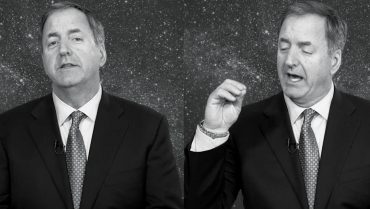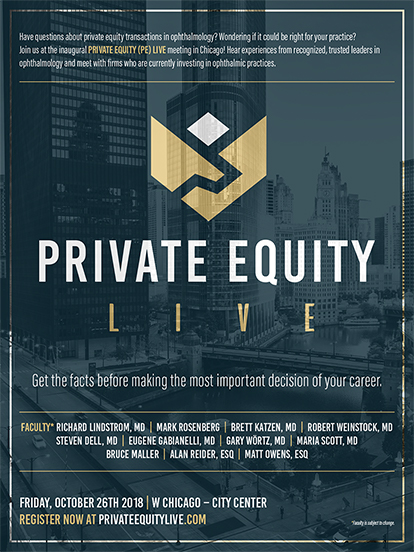BMC: Who or what drew you to ophthalmology?
Vance Thompson, MD, FACS: My dad and grandpa were both small-town family doctors in South Dakota. I thought I would be a family doctor, too. My friend in medical school, Peter Sneed, MD, would tell me about his father, who was an ophthalmologist. Peter is the one who planted that seed in my mind. I also spent time with John Willcockson, MD, during medical school. It just blew me away—the microsurgery and the idea of restoring vision.
I’ll never forget telling my dad, that Christmas during my junior year in medical school, “I am not going to be a family doctor. I think I’m going to be an eye surgeon.” I remember him saying, “So, which eye are you going to specialize in?” He was eventually very proud of me, but in the beginning that family-doctor-versus-specialist thing kind of showed.
BMC: Did any of this influence your feelings toward collaborative eye care?
Dr. Thompson: My time in the fellowship of Daniel S. Durrie, MD, catapulted my research career and exposed me to working with optometry. It taught me a lot about the value of relationships with referring doctors. And so, when I came back home in 1991, I was excited to deliver refractive and cataract surgery and to collaborate with optometry and build a referral network. Probably the most impactful step I took was asking an optometrist to join me in practice. And he’s been with me almost my whole career. That’s Doug Wallin, OD, who had done similar training in refractive and cataract surgery and pre- and postoperative care with Richard Baker, OD; Stephen G. Slade, MD; and Ralph Berkeley, MD, when they were all together in Houston.
BMC: It seems that you value teamwork. How did you form your team?
Dr. Thompson: Well, I think it goes to the core of what I want: I want to serve my fellow man well. I guess it’s a passion to please, or a passion to serve. That applies to everyone—the people I work with, the patients I see, and the referring doctors who collaborate with me. It comes down to hard work, creative thinking, and being fascinated with the journey. I don’t know if this is an appropriate place to talk about this, but I’m fascinated with rock music documentaries.
BMC: What about them do you find fascinating?
Dr. Thompson: They show how the sum is greater than the parts, and how rare it is for members of a rock and roll group who made beautiful music together to break up and achieve the same success apart. I think about that when thinking about teams. I happen to be fascinated with greatness, and working with people who are great inspires me.
I’m a drummer. I am fascinated with great drumming. I’m not that good at drumming, but I know enough about it that I can recognize greatness. When you see Yo-Yo Ma play his cello, you get this feeling in you that recognizes—and is amazed with—greatness. I can get that same feeling in a meeting with my team when we’re trying to answer a complex question. When I hear a unique idea and recognize it, there’s joy and excitement in recognizing it. One of my favorite things is drafting the right people for a team that will create a masterpiece.
BMC: What’s the role of the surgeon in educating the patient, and what’s the role of the optometrist?
Dr. Thompson: It’s so important that patients understand the basics of—and the risks and benefits of—a surgical procedure. It falls on eye care providers to review technology options; this responsibility has grown more complex as the number of technologies has grown.
I’ll use premium cataract surgery as an example. Cataract surgery is such a commonly performed procedure that it’s easy to fall into a routine of not spending enough time talking about the implant options. These implants have been innovated in amazing ways, and our patients really appreciate it when we take the time to explain the advantages and disadvantages of monofocality, multifocality, extended depth of focus, and accommodating lenses. It helps so much if the optometrist and the surgeon are both educating on these options, so that the patient can participate in the decision-making process of a lifelong choice.
The majority of patients in this country are seen by optometrists first, and I always tell patients, “You want to talk to the provider who has taken care of you for years and get their opinion. That’s who you built your trust with.” I also tell them that they should do some internet research on the type of lens they want. I warn them that some of what they’ll find on the internet is unreliable, but that a surgical practice such as ours can help them to understand what we believe is real and what’s not real.
BMC: It sounds like you think that collaboration is key.
Dr. Thompson: The collaborative part is just so important. There are so many patients in need, and optometry and ophthalmology need to create a powerful one-two punch to provide the best surgical care and education for the patient. Optometrists and ophthalmologists must read the literature and trade publications and attend conferences so that they can bring their A game to educating a patient on what they would do if it was their eyes or the eyes of their family member.
Consider a 40-year-old cataract patient whose disease has affected her nighttime driving, but she is still satisfied with her computer and morning make-up applying vision. If such a patient is uneducated about the options, she will be fit with a monofocal IOL. Then she shows up in the surgeon’s office postoperatively, unhappy because she went from the accommodation of a 40-year-old to the accommodation of a 70-year-old because absolute presbyopia was induced by the monofocal implant. The patient never learned about multifocality or extended depth of focus IOLs, and she is frustrated. That’s what we’re trying to prevent.
BMC: Then the MD and the OD really need to be on the same page when it comes to education, correct?
Dr. Thompson: Yes, but we can’t forget about the staff. To me, staff members are part of the education team. When we use the phrase the optometrist and the ophthalmologist, we’re really talking about the clinic as a whole—the entire team. It’s important to educate the team about how the doctor thinks because patients spend a significant amount of their time with staff members. A well-educated staff member can do so much to optimize not only patient education but also the patient experience.
Our team does a huddle every morning. We talk about something educational or experiential. We record the huddle and offer it to team members who were unable to be there that morning. We encourage everybody to watch that video. Then a couple times a year we shut down our center and have retreats with our team to educate them on what we do so we can all keep up with the advancements that are happening at an amazing pace.
BMC: If you had to nominate one creative mind in ophthalmology, whom would it be and why?
Dr. Thompson: You’re already profiling him in this series, but I would say my partner, whom I share an office with every day, John P. Berdahl, MD. He uses his creativity to solve problems big and small—and does it with such zeal that it’s fun to watch.
Excellence and creativity fascinate me; therefore, John fascinates me. Problem solving permeates every aspect of his life—whether it is related to the first noninvasive titratable goggles to treat glaucoma on earth and help outer space ocular therapy or optimizing the patient experience in our office. He enjoys trying to make a great thing even better and, wow, that makes for a fun partnership.





